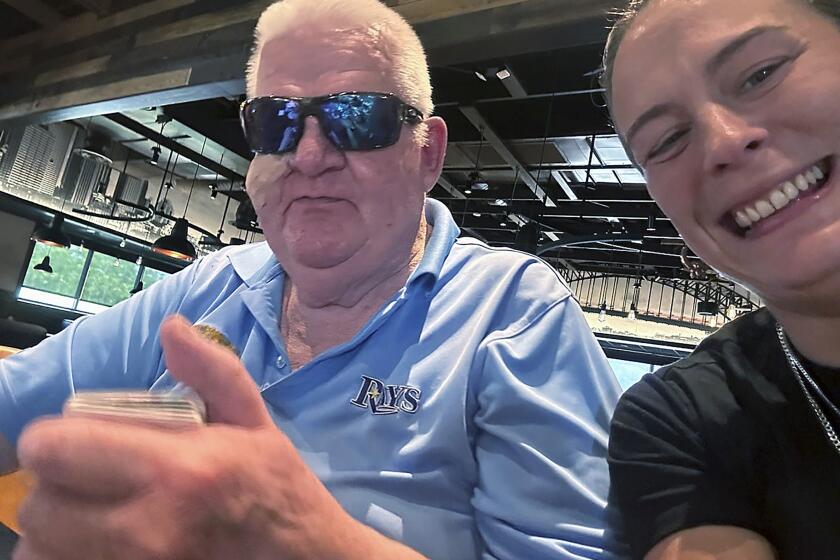Were Fired Reporters Too Aggressive?
MELBOURNE, Fla. — By the time the two reporters arrived at the Hickory Avenue housing project, the apartment of jailed murder suspect Anita Gonzales was a mound of rubble--broken furniture, scattered clothes, a jumble of paper and trash. The police had come and gone, declaring the small duplex plucked clean of evidence. Then came the public, traipsing through the open door to scavenge in the untended debris.
So, on a tip that the apartment was headquarters for a teenage crime operation, John McAleenan and Kathy Reakes from Florida Today stepped through the open door and roamed through the disorder. While they were there, they picked up several pieces of paper, they said, including one that looked like journalistic pay dirt: a list of names, telephone numbers and beeper numbers.
“I thought, ‘Wow, this was not simply another murder. This looked like a Fagan running a gang of young criminals here in Brevard County,’ ” said McAleenan a few days later. “I thought, ‘This is one hell of a story. “‘
But within 24 hours, McAleenan, a 62-year-old columnist, and Reakes, a 40-year-old crime reporter, were fired. They were advised to get their own lawyers and told to turn themselves in to police.
“Since you have admitted to us that you entered the property and removed material, we will notify police today if you fail to do so by 10 a.m.,” Executive Editor Judy P. Christie of Florida Today said in a letter dated Feb. 1 to the two reporters.
The reporters refused to turn themselves in on the advice of their attorney. The paper then reported the incident to authorities and handed over several documents purported to be the ones taken from the apartment. The reporters are now facing a grand jury investigation of possible trespassing and other charges. After news reports about the two journalists, police are also investigating complaints from the Gonzales family that some valuable items had been stolen from the apartment.
Christie and other executives at the newspaper would not comment on the dismissals, citing a policy against speaking about personnel matters. But the firings at Florida Today--a Gannett newspaper nationally known as the precursor to USA Today--have launched debate and even distress elsewhere in the journalism community.
In sunny, oceanside Brevard County, the story of McAleenan and Reakes has put journalists and some of the public at odds. For those who rail against the excesses of the media, it is comeuppance, and at least one Orlando radio show has featured citizens expressing outrage that the two would step into the apartment while its former tenant--who was being evicted at the time--was in jail. Similarly, a few police officers have suggested that the troubles faced by the two reporters are not unlike those encountered by police officers who find they have broken the rules in the pursuit of criminals.
*
But to many journalists, the case is quickly becoming an example of how their once-rowdy profession has changed into an increasingly cautious business. Moreover, the paper’s treatment of the two journalists seems to upend an old code that said good editors always bend over backward to protect good journalists in pursuit of the news.
Asked about how this case fits with that code, Melinda Meers, Florida Today’s managing editor, who has been fielding reporters’ questions for Gannett management, said that “Florida Today does support its reporters.” But she refused further comment on the McAleenan and Reakes firings.
Others, including a few former Gannett editors, are not so reticent.
“It is embarrassing and outrageous that a newspaper doesn’t stand behind the reporter’s efforts at investigating a story,” said John Quinn, the first editor of Gannett’s USA Today and now deputy chairman of The Freedom Forum, which pursues issues of importance to the media. Bill Kovach, curator at the Nieman Foundation at Harvard, said that while the reporters should not have picked up the papers and could have easily taken down the numbers in their notebooks, the managers of Florida Today had acted “abominably” by firing the reporters, by turning documents over to authorities and refusing to explain the paper’s rationale.
“I don’t believe I’ve seen anything like it before,” said Kovach, a former editor at the New York Times and the Atlanta Constitution. “I’m not sure how a newspaper can monitor other institutions of power if they’re going to work like this.”
At a hearing Feb. 7, attorneys for the newspaper passed along the documents to a local judge and asked him to open the sealed envelope privately in his chambers. The request brought Maurice Tamman, Florida Today’s court reporter, to his feet to protest. As he put it, he was asking that the papers be unsheathed in public--not in the name of his employer but on behalf of other journalists and the public.
“What has happened to us when the newspaper is turning documents in to authorities and trying to keep these documents from the press?” said Reakes, as she sipped a cup of coffee earlier this week at a beachside restaurant. “Newspapers are run by the lawyers now, and what they really worry about is the bottom line, not the story. It’s scary.”
*
Reporters at Florida Today, who spoke on condition of anonymity, said they knew of no training sessions warning reporters that what McAleenan and Reakes did was viewed by the company as wrong. But after the firings, they said a company lawyer advised them that “no laws” were to be broken in the pursuit of news. No traffic laws, no misdemeanors, no “gray areas,” the lawyer had reportedly said.
“If I were a reporter at any Gannett newspaper now, I would be very nervous,” said one former editor at Gannett.
Many of the journalists also expressed dismay at how quickly two veterans were fired--especially McAleenan, who was three years away from retirement and whose column was one of the local favorites.
McAleenan, who began working in 1955 as a newsman, said: “If you had asked me how the paper would have reacted to what we did on this one, I would have said they would give us a reward.”
That’s what happened to McAleenan in 1978, when police began to first suspect serial killer John Wayne Gacy, later convicted and executed for murdering 33 youths in his suburban Chicago home. McAleenan was working for the Detroit News, which sent him to investigate in the Chicago suburb where Gacy lived.
“I went to the house, and it was sealed off,” McAleenan recalled. “But the next morning I went back to take another look, and the police lines were down. A big truck was excavating the basement and I walked into the house to get a little color. As I walked out, detectives were coming in. They said, arrest this man for trespassing, and I was arrested, and the photographer bailed me out. I was in the news all that day.
More to Read
Sign up for Essential California
The most important California stories and recommendations in your inbox every morning.
You may occasionally receive promotional content from the Los Angeles Times.










